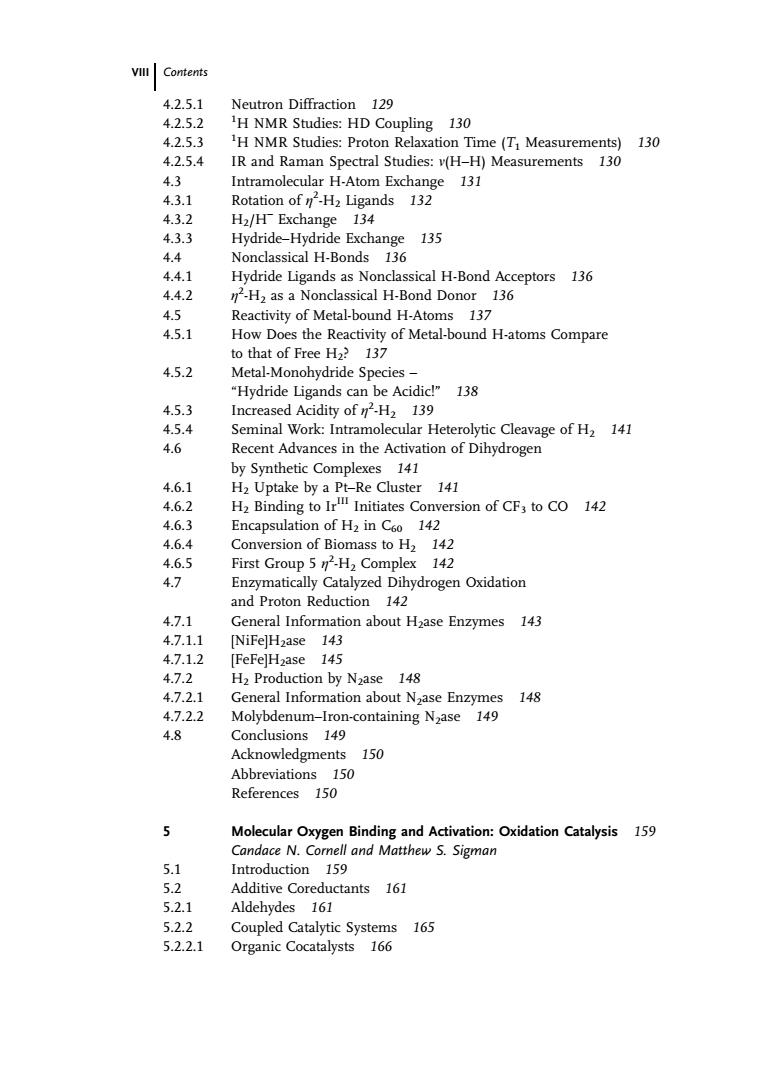正在加载图片...

Contents 4.2.5.1 Neutron Diffraction 129 4252 'H NMR Studies:HD Coupling 130 4.25.3 H NMR Studies:Proton Relaxation Time(T Measurements)130 42.5.4 IR and Raman Spectral Studies:v(H-H)Measurements 130 amolecular H-Aton 131 atio 132 change 135 Nor H-Bonds 44.1 Hydride Ligands as Nonclassical H-Bond Acceptors 136 4.42 y2.H2 as a Nonclassical H-Bond Donor 136 4.5 Reactivity of metal-bound H-Atoms 137 4.5.1 How Does the Reactivity of Metal-bound H-atoms Compare to that of Free h 137 4.5.2 Metal-Monohvdride species "Hydride Ligands can be Acidic!" 138 453 Increased Acidity of H,139 45.4 Seminal work:Intramolecular heterolvtic clea avage of H2 141 4.6 Recent Advances in the Activation of Dihydr V S mthetic Cor ptake by 14 142 encaps of H2 in Coo ersion of Bi mass to H2 First Group 5H2 Complex Enzymatically Catalyzed Dihydrogen Oxidation and Proton Reduction 142 4.7.1 General Information about H2ase Enzymes 143 4.7.11 [NiFe]Hzase 143 4.7.1.2 [FeFe]Hzase 145 4.7.2 H2 Production by Nase 148 4721 General Information about Nase Enzymes 148 4722 Molybdenum-Iron-containing Nzase 14g 4.8 Conclusions 149 Acknowledgments 150 Abbreviations 150 rences 150 5 Molecular Oxygen Bind Activation:Oxidation Catalysis 159 Candace N.Corne 5 Introduction Additive Coreductants 167 5.2.1 Aldehydes 161 5.2.2 Coupled Catalytic Systems 165 5.2.2.1 Organic Cocatalysts 166 4.2.5.1 Neutron Diffraction 129 4.2.5.2 1 H NMR Studies: HD Coupling 130 4.2.5.3 1 H NMR Studies: Proton Relaxation Time (T1 Measurements) 130 4.2.5.4 IR and Raman Spectral Studies: (H–H) Measurements 130 4.3 Intramolecular H-Atom Exchange 131 4.3.1 Rotation of 2 -H2 Ligands 132 4.3.2 H2/H– Exchange 134 4.3.3 Hydride–Hydride Exchange 135 4.4 Nonclassical H-Bonds 136 4.4.1 Hydride Ligands as Nonclassical H-Bond Acceptors 136 4.4.2 2 -H2 as a Nonclassical H-Bond Donor 136 4.5 Reactivity of Metal-bound H-Atoms 137 4.5.1 How Does the Reactivity of Metal-bound H-atoms Compare to that of Free H2? 137 4.5.2 Metal-Monohydride Species – “Hydride Ligands can be Acidic!” 138 4.5.3 Increased Acidity of 2 -H2 139 4.5.4 Seminal Work: Intramolecular Heterolytic Cleavage of H2 141 4.6 Recent Advances in the Activation of Dihydrogen by Synthetic Complexes 141 4.6.1 H2 Uptake by a Pt–Re Cluster 141 4.6.2 H2 Binding to IrIII Initiates Conversion of CF3 to CO 142 4.6.3 Encapsulation of H2 in C60 142 4.6.4 Conversion of Biomass to H2 142 4.6.5 First Group 5 2 -H2 Complex 142 4.7 Enzymatically Catalyzed Dihydrogen Oxidation and Proton Reduction 142 4.7.1 General Information about H2ase Enzymes 143 4.7.1.1 [NiFe]H2ase 143 4.7.1.2 [FeFe]H2ase 145 4.7.2 H2 Production by N2ase 148 4.7.2.1 General Information about N2ase Enzymes 148 4.7.2.2 Molybdenum–Iron-containing N2ase 149 4.8 Conclusions 149 Acknowledgments 150 Abbreviations 150 References 150 5 Molecular Oxygen Binding and Activation: Oxidation Catalysis 159 Candace N. Cornell and Matthew S. Sigman 5.1 Introduction 159 5.2 Additive Coreductants 161 5.2.1 Aldehydes 161 5.2.2 Coupled Catalytic Systems 165 5.2.2.1 Organic Cocatalysts 166 VIII Contents�